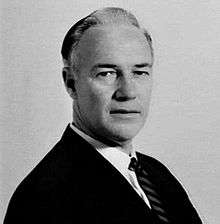Pat Hills
| The Honourable Pat Hills AO | |
|---|---|
 | |
| 6th Deputy Premier of New South Wales | |
|
In office 30 April 1964 – 13 May 1965 | |
| Premier | Jack Renshaw |
| Preceded by | Jack Renshaw |
| Succeeded by | Charles Cutler |
| 22nd Leader of the Opposition of New South Wales Elections: 1971, 1973 | |
|
In office 2 December 1968 – 17 November 1973 | |
| Deputy | Syd Einfeld |
| Preceded by | Jack Renshaw |
| Succeeded by | Neville Wran |
| 70th Lord Mayor of Sydney | |
|
In office 9 December 1952 – 30 November 1956 | |
| Preceded by | Ernest Charles O'Dea |
| Succeeded by | Harry Jensen |
| Personal details | |
| Born |
31 December 1917 Sydney, Australia |
| Died |
22 April 1992 (aged 74) Sydney, Australia |
| Resting place | Northern Suburbs Memorial Gardens |
| Nationality | Australian |
| Political party | Labor |
| Spouse(s) | Stella Steele Hills |
Patrick Darcy 'Pat' Hills AO (31 December 1917 – 22 April 1992) was a New South Wales politician. He served in various high offices across the state most notably the Deputy Premier of New South Wales, Leader of the Opposition and as the Lord Mayor of Sydney.
Early life
Hills was born in the Sydney suburb of Surry Hills. He was educated at Marist Brothers High School, Darlinghurst and was apprenticed as an electrical engineer.
He was an alderman on Sydney City Council from 1948 to 1956 and Lord Mayor of Sydney from 1953 to 1956, when only in his thirties.
Political career
Hills was elected to the New South Wales Legislative Assembly as the member for Phillip in 1954, representing the Australian Labor Party; he held the seat till its abolition in 1981. Then, until 1988, he served as member for Elizabeth.
He was Minister for Local Government in the cabinet of Premier Robert Heffron (1959-1964), and Deputy Premier under Heffron's successor Jack Renshaw. Following Renshaw's departure from the Labor leadership, Hills was the State Opposition Leader from 1968 to 1973; at the 1971 and 1973 state elections he was narrowly defeated by the Liberal Premier, Sir Robert Askin.
During his long Parliamentary service of 34 years, Hills served terms as Deputy Premier and as Minister in a number of portfolios including Local Government, Highways, Mines, Energy, Industrial Relations, Technology, Roads and Employment. In opposition he served as Deputy Leader for three years and Leader for five years. His many notable initiatives and achievements as a Minister include the Sydney to Newcastle Highway, the construction of the Gladesville Bridge and establishment of the State Planning Authority now known as the NSW Department of Planning. One of his major achievements was the building of the Eraring and Bayswater power stations.
He was also responsible for the Hilton Hotel, which he rubber stamped. More importantly, he has been accused of sabotaging the 1948 Cumberland County Plan for Sydney, "flogging the green belt out the back door before the ink was dry".[1]
He served as a member of the Sydney Cricket Ground and Sports Ground Trust from July 1961 to December 1989, and was Chairman of the Trust during its significant expansion period from 1977 to 1989. Hills died in Sydney and was cremated with his ashes interred at Northern Suburbs Memorial Gardens.
Honours
Hills was appointed as an Officer of the Order of Australia in 1988.[2]
The suburb of Hillsdale, New South Wales is named after Hills.
References
- ↑ http://www.smh.com.au/comment/a-real-city-needs-more-than-just-tying-up-loose-ends-20141217-128zdi.html
- ↑ "The Hon. Patrick Darcy Hills (1917 - 1992)". Members of Parliament. Parliament of New South Wales. Retrieved 20 February 2010.
| Government offices | ||
|---|---|---|
| Preceded by William Parker Henson |
Chairman of the Sydney County Council 1952 – 1954 |
Succeeded by Harry Jensen |
| Civic offices | ||
| Preceded by Ernest Charles O'Dea |
Lord Mayor of Sydney 1952 – 1956 |
Succeeded by Harry Jensen |
| Parliament of New South Wales | ||
| Preceded by Tom Shannon |
Member for Phillip 1954 – 1981 |
District abolished |
| New district | Member for Elizabeth 1981 – 1988 |
District abolished |
| Political offices | ||
| Preceded by Jack Renshaw |
Minister for Local Government 1959 – 1965 |
Succeeded by Pat Morton |
| Minister for Highways 1959 – 1965 | ||
| Deputy Premier of New South Wales 1964 – 1965 |
Succeeded by Charles Cutler | |
| Leader of the Opposition of New South Wales 1968 – 1973 |
Succeeded by Neville Wran | |
| Preceded by George Freudenstein |
Minister for Mines 1976 – 1978 |
Succeeded by Ron Mulock as Minister for Mineral Resources and Development |
| Minister for Energy 1976 – 1981 |
Succeeded by Paul Landa | |
| Preceded by Paul Landa |
Minister for Industrial Relations 1976 – 1988 |
Succeeded by John Fahey as Minister for Industrial Relations and Employment |
| New title | Minister for Technology 1978 – 1980 |
Succeeded by Ron Mulock |
| Preceded by Ron Mulock |
Minister for Technology 1981 – 1984 |
Succeeded by George Paciullo |
| Preceded by George Paciullo |
Minister for Roads 1984 |
Succeeded by Laurie Brereton |
| Preceded by Bob Debus |
Minister for Employment 1986 – 1988 |
Succeeded by John Fahey as Minister for Industrial Relations and Employment |
| Party political offices | ||
| Preceded by Jack Renshaw |
Deputy Leader of the Australian Labor Party (NSW Branch) 1964 – 1968 |
Succeeded by Syd Einfeld |
| Preceded by Jack Renshaw |
Leader of the Australian Labor Party (NSW Branch) 1968 – 1973 |
Succeeded by Neville Wran |